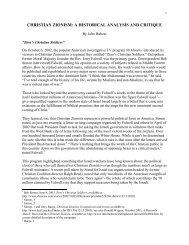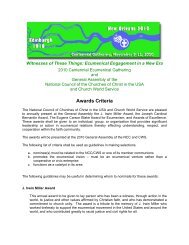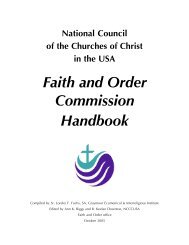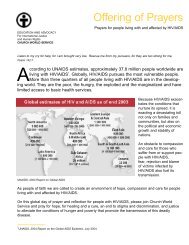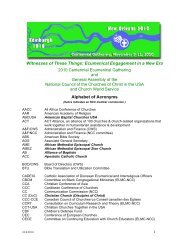Common Agreement on Mutual Recognition of Baptism - National ...
Common Agreement on Mutual Recognition of Baptism - National ...
Common Agreement on Mutual Recognition of Baptism - National ...
Create successful ePaper yourself
Turn your PDF publications into a flip-book with our unique Google optimized e-Paper software.
1493<br />
1494<br />
1495<br />
1496<br />
1497<br />
1498<br />
1499<br />
1500<br />
1501<br />
1502<br />
1503<br />
1504<br />
1505<br />
1506<br />
1507<br />
1508<br />
1509<br />
1510<br />
1511<br />
1512<br />
1513<br />
1514<br />
1515<br />
1516<br />
1517<br />
1518<br />
1519<br />
1520<br />
1521<br />
1522<br />
1523<br />
1524<br />
1525<br />
1526<br />
1527<br />
1528<br />
1529<br />
1530<br />
1531<br />
1532<br />
1533<br />
1534<br />
1535<br />
1536<br />
1537<br />
Roman Catholic baptismal rites include both pre-baptismal and post-baptismal elements<br />
which help to prepare for and delineate the mystery experienced in baptism. In effect, the prebaptismal<br />
rites within the RCIA are intended, as described above, to invite and stimulate a desire<br />
for God, membership in Christ‘s body, the Church, and in the ability to pr<strong>of</strong>ess faith (see LG no.<br />
11 <strong>on</strong> the effects <strong>of</strong> baptism; see also Can. 849 in the 1983 Code <strong>of</strong> Can<strong>on</strong> Law). The ―lead-up‖<br />
<strong>of</strong> the extended catechumenate now in place in the reformed rites <strong>of</strong> adult baptism is the fertile<br />
ground for enabling the grace <strong>of</strong> baptism to take root deeply in the hearts <strong>of</strong> those well prepared<br />
to receive it. C<strong>on</strong>versi<strong>on</strong> is work: n<strong>on</strong>e who desires to be baptized can be expected to prepare<br />
themselves apart from a community which will give them membership and bel<strong>on</strong>ging. The prebaptismal<br />
rites also serve the valuable purpose <strong>of</strong> acquainting the catechumen with the<br />
community he or she will call ―home‖ for at least some time through the period <strong>of</strong> mystagogia.<br />
Likewise, the community must prepare itself to admit new members and thereby deepen its own<br />
commitment by expanding yet again the boundaries <strong>of</strong> its love and missi<strong>on</strong>.<br />
The post baptismal elements, whether <strong>of</strong> the adult or infant rites, have a single overall<br />
purpose: they serve to unfold, explain and detail major aspects <strong>of</strong> what has just happened in<br />
water baptism. Though not essential to the sacramental acti<strong>on</strong> <strong>of</strong> God just experienced, they<br />
nevertheless make clear to all – minister, witnesses, family and community members – that the<br />
new Christian now enjoys the rights and obligati<strong>on</strong>s <strong>of</strong> membership in Christ‘s body.<br />
When anointed with chrism, the newly baptized and c<strong>on</strong>firmed are sealed in their priestly<br />
role to participate in the Eucharist and in their ability to share in marriage and Orders. Clothing<br />
with a white garment signals the beauty and sin-free quality <strong>of</strong> their new lives now lived in<br />
Christ, washed clean <strong>of</strong> original and actual sin. Like the linen garments worn by the baptized <strong>of</strong><br />
l<strong>on</strong>g ago, white-colored clothing also serves as a reminder and pledge against the temptati<strong>on</strong> to<br />
sin which will never leave their lives. The presentati<strong>on</strong> <strong>of</strong> the lighted candle is a joining <strong>of</strong> their<br />
commitment to live according to the light <strong>of</strong> Christ as symbolized by the great Easter candle <strong>of</strong><br />
the Vigil at which the adults were baptized. This candle also solemnizes their vow-taking, as<br />
marked in many other rites within the Roman Catholic Church either for weddings, m<strong>on</strong>astic<br />
vows, the c<strong>on</strong>secrati<strong>on</strong> <strong>of</strong> virgins or the annual renewal <strong>of</strong> baptismal promises at the Easter Vigil.<br />
Finally, the Ephphetha cerem<strong>on</strong>y brings with it the special grace to hear the Word <strong>of</strong> God and<br />
speak it as a part <strong>of</strong> the missi<strong>on</strong> and life <strong>of</strong> the baptized. With this rite, which orients the new<br />
believer to the preaching <strong>of</strong> the Word in life, word and deed, the rite for baptism closes <strong>on</strong> an<br />
evangelical in imitati<strong>on</strong> <strong>of</strong> Christ who came to serve and not to be served (cf. Mt. 20.28).<br />
Method in the Reform <strong>of</strong> the Roman Catholic <strong>Baptism</strong>al Rites<br />
As menti<strong>on</strong>ed above, the reform <strong>of</strong> the liturgy following the Sec<strong>on</strong>d Vatican Council was<br />
d<strong>on</strong>e according to goals never before adopted in the Roman Catholic Church. Specifically, the<br />
revisi<strong>on</strong> <strong>of</strong> rites and texts was made with the overarching purpose <strong>of</strong> deepening the ―full,<br />
c<strong>on</strong>scious and active participati<strong>on</strong>‖ <strong>of</strong> the faithful in the acti<strong>on</strong> <strong>of</strong> God present in the liturgy (SC,<br />
14). Inherently, this goal carried new methodological c<strong>on</strong>siderati<strong>on</strong>s as well, demanding a<br />
theological and liturgical understanding <strong>of</strong> the rite and texts unlike what was previously needed.<br />
The Council itself would give some directi<strong>on</strong> for the development <strong>of</strong> this method in its<br />
statements that there was no further need for ―uniformity‖ but <strong>on</strong>ly for ―unity‖ in the reformed<br />
rites (SC, 23); that all <strong>of</strong> the existing rites from Trent should be, in effect, simplified and made<br />
42



